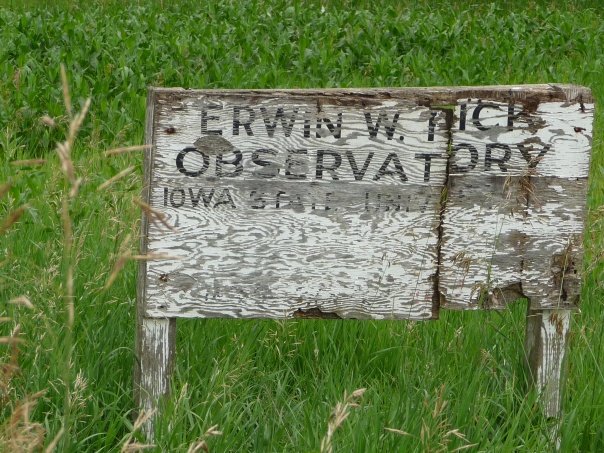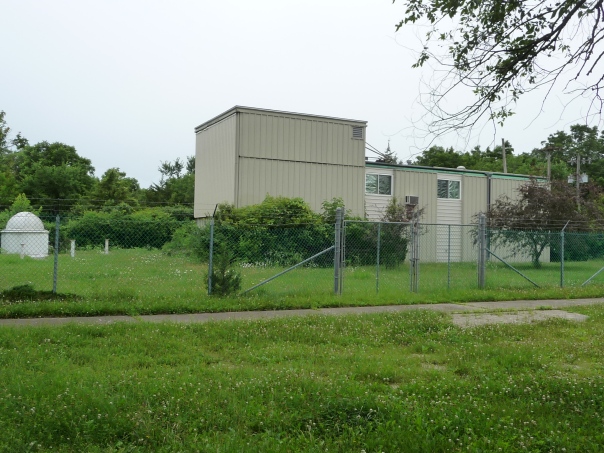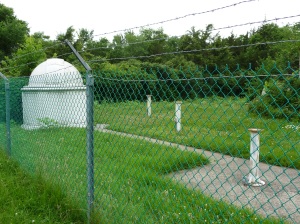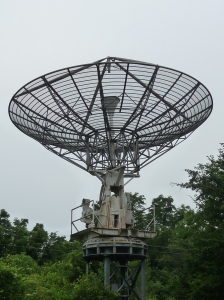For nearly 40 years, Iowa State University students and researchers made nightly drives west to a humble steel building in a wooded clearing southwest of Boone.
When skies were clear, they would roll back the roof and fire up a 24-inch reflector telescope and other, smaller instruments to focus on distant stars and galaxies.
But a visit to the Erwin W. Fick Observatory today finds no students or professors and little more than weeds. ISU has closed it and moved most of the telescopes and equipment to campus.
For the first time in decades, Iowa State has no major astronomical facility – and it’s unlikely to ever have one again.
The Fick Observatory never was beautiful, like the Drake Municipal Observatory in Des Moines. Its plain tan exterior could just as easily have housed combines and plows as telescopes.
Now, however, it’s even more humble. Your faithful correspondent risked mosquitoes, ticks (I HATE those eight-legged suckers) and a trespassing arrest to visit this month. The wood sign marking its location is barely legible. The lane leading to the building is passable but grass-covered. Besides the main building, there are small outdoor mounts for small telescopes, a small domed observatory and a huge satellite dish – the remains, I am told, of a radio telescope that was part of an electrical engineering senior project that ended in the early 2000s.
You can find details about the Fick’s founding and its major telescope, named for Milo Mather, here. Money for the observatory came from Erwin W. Fick, a Davenport engineer and amateur astronomer who never attended or visited Iowa State, in the late 1960s. The facility bearing his name was built in 1970 with that bequest and a grant from the National Science Foundation.
Over the years, the telescope was upgraded and equipment added, including charge-coupled devices (essentially digital cameras), a spectrometer and other instruments. Joseph Eitter was the observatory’s only manager and apparently the key to its operation, as ISU’s Skip Derra noted in a 2002 story.
Eitter and other scientists performed significant research on the Mather telescope, including making thousands of measurements of stellar radial velocity over years of observing.
When Eitter retired in 2008, however, his position was cut. That was the last year the Mather telescope was used for observation, says Frank Krennrich, chairman of the ISU Department of Physics and Astronomy. Eitter died last year. The observatory’s water and gas were shut off in March.
Last fall representatives from the department, the College of Agriculture and Life Sciences, the Provost and Facilities Planning & Management office toured the facility and property. The group decided it was time to close the observatory for good, ISU spokesman John McCarroll said in an email.
It’s part of a national trend, Krennrich says: Many smaller telescopes across the country are shutting down due to lack of financing and the rising dominance of larger research facilities.
Besides that, there are issues specific to the Mather instrument. “It’s an old-fashioned telescope” and “technology has changed dramatically” since it was built, Krennrich said. For example, the Mather telescope has an equatorial mount, allowing it to track stars along a single axis. Newer telescopes move along two axes, allowing for computer control and tracking.
The Mather telescope also is too small. “Astronomers are going much more toward large facilities today,” Krennrich said. Replacing Fick’s telescope with a modern instrument suitable for research would cost at least $500,000.
So, at bottom, the problem is the same as always. “The facility just costs us money,” Krennrich said, and an ISU Foundation account for its upkeep is running out. (McCarroll said there is about $50,000 left.) The building’s roof is leaking and “it’s not a positive climate for providing funding.”
While little research has been done there in recent years, the observatory “did provide a good educational purpose,” Krennrich said. The site, in the wilds of the Des Moines River valley, had reasonably dark skies. Professors took students there to observe with smaller telescopes and to teach them the basics of celestial coordinates and other principles.
Now Iowa State students do their observing from the top of the Zaffarano addition to the Physics Building on campus – in the middle of light pollution from Ames and Des Moines. “It works, but it’s not as beautiful,” Krennrich said.
In that respect, ISU joins the University of Iowa, which last year named a revamped and refurbished on-campus observatory for famed physicist James Van Allen. U of I’s telescopes also must fight light pollution, but a group of physics and astronomy students recently installed a remotely operated telescope at an Arizona observatory. The Van Allen Observatory and Arizona installation means the university no longer sends students and faculty to telescopes at the Palisades-Dows Observatory near Mount Vernon, operated by the Cedar Amateur Astronomers club.
Krennrich said the Fick’s shutdown is “clearly a loss to the university and the physics department,” but raising money to replace it or buy a new telescope seems unrealistic. “Unless a big donor comes in and says ‘I want to fund a big telescope for the university’” there’s little chance ISU will operate one again.
Further weakening the argument for a new facility, he added, is that few faculty members are likely to use one for research. Most have access to large ground- or space-based instruments, like the VERITAS gamma ray telescope Krennrich uses or the Spitzer Space Telescope.
Yet, Krennrich acknowledges it would be nice to have some kind of dark-sky location – “I don’t even want to call it an observatory” – with platforms for small telescopes. But there is, of course, the issue of money.
Under the endowment agreement, when the funds can on longer be used to support the observatory’s use, the ISU Foundation will consult with the Dean of Liberal Arts and Sciences and the Physics and Astronomy Department chair about how to use it.
The ISU administration now controls the site. McCarroll, quoting Senior Vice President for Business and Finance Warren Madden, said no decision has been made about its fate – but a salvage company is removing metal from the building for recycling.
Whatever the decision, someone will have to deal with the Mather telescope. The astronomers left it behind and “we have not put a claim on it,” Krennrich said. Moving it would be a huge task: “It’s a beast of an instrument.”




This is a horrible loss for past, present, and future Iowa State students, the ISU Department of Physics & Astronomy, for Iowa State University, and for the state of Iowa. At a time when modern quantum-efficient detectors and instrumentation are able to give new life to smaller instruments (such as the Erwin W. Fick Observatory 24-inch research telescope), there are literally hundreds of valuable research projects that could be accomplished that would have been impossible even just a few years ago. The site is still a good site, far enough away from major light pollution sources, and with a modest financial investment the building could be used for many years to come. It is clear that the powers that be, even in the physics & astronomy department, have no vision beyond “big science”, and countless future undergraduate and graduate students are being deprived of the wonderful life-changing opportunities I had in observational astronomy there as an undergraduate and graduate student. If Joe Eitter were still living, the closing of Fick Observatory would break his heart as it has mine. I have the vision and energy to make this a productive facility once again but, alas, no money. Will anyone step forward? Are we already in an era when astronomical research and always-important basic data collection is accessible only to a very small number of professional astronomers and wealthy amateurs? And we wonder why we have a society that is increasingly science-illiterate. For most (who even care), science is no more than a spectator sport, and opportunities to actually participate in scientific research are diminishing.
David, thanks for the comment. I agree with you. I don’t have the astronomical expertise to say whether the Mather telescope could still be a useful research tool, but I know you are an authority (I interviewed you about dark skies back when I was with the Register) and I trust you’re right about its potential. ISU and the physics and astronomy department clearly have no interest in raising money for the Fick Observatory, but if a groundswell of support (with money behind it) arose, I think they would jump at the chance to revive it. I’m not in a position to stage such a campaign, but perhaps you, the Ames Area Amateur Astronomers and others could get some momentum.
TO
Thanks, Thomas, nice to talk with you again after all these years! I think Fick Observatory needs a new owner – one that is dedicated to public education, fostering amateur and undergraduate research, and that will make it available to students and faculty at colleges and universities in and beyond central Iowa that presently do not have access to a research telescope. Correct me if I am mistaken, but I believe that with the closing of Fick Observatory, Iowa has lost its only college/university research observatory that is located at a dark-sky site (i.e. not on campus in town).
Clear, dark, and starry skies,
Dave
>
Dave,
I think you’re right. UNI’s observatory is on campus, as is Grinnell’s. I don’t know about the smaller colleges around the state; you’d be more of an expert on that. As I noted, U of I has remote access to a scope at an Arizona site, presumably in a dark sky location. That may be the wave of the future.
Best wishes,
TO
[…] ISU constructed the observatory in the 1960s, financed with a bequest from Davenport amateur astronomer Erwin Fick. You can read more about its history and why ISU pulled out in my 2015 post. […]